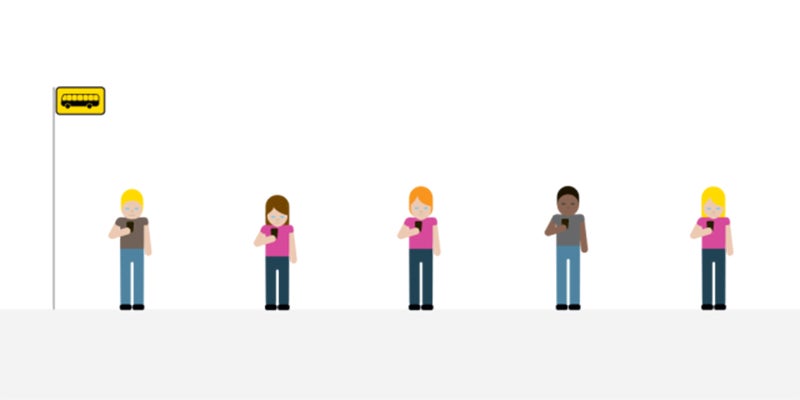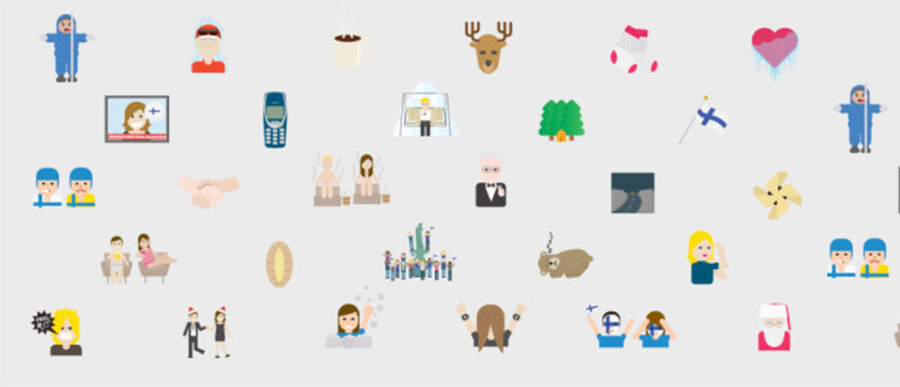Emojis are a nearly universal language – symbols that speak clearly across cultures. But Finland has created a set that has a more singular focus: putting a clever and fun spin on the culture and identity of the country.
Petra Theman, director for public diplomacy at the Finnish Ministry of Foreign Affairs, joined the Knowledge at Wharton show on Wharton Business Radio, SiriusXM channel 111, to talk about it. Later in the show, marketing expert Anna Blender of BAV Consulting offered her views on Finland’s unusual approach to getting attention and what they are doing right.
An edited transcript of the conversations appears below.
Knowledge at Wharton: First, explain the idea. How did this all come about?
Petra Theman: Well, it came to us when we were thinking about a Christmas calendar that we do yearly called “This Is Finland.” We were thinking, what can we do that would work better on mobile, would be more fun, and talk to a younger audience than our normal Christmas calendar? So that was the background for the idea.
 Knowledge at Wharton: The emojis that you’ve come up with — some of them relate to the history of Finland. But some, I have no idea where they fit in. So we can go through this. The headbanger thing, I read, came about because there are so many metal bands there, correct?
Knowledge at Wharton: The emojis that you’ve come up with — some of them relate to the history of Finland. But some, I have no idea where they fit in. So we can go through this. The headbanger thing, I read, came about because there are so many metal bands there, correct?
Theman: That is true, we could not miss the metal band, the headbanger. I think we have more metal bands per capita than any other country in the world, so that was a given. We even have metal bands for children.
“The only thing you can do is be honest and be yourself and be very, very wary of where the younger generation moves. You don’t want to look like an idiot either, trying to talk to youngsters.” –Petra Theman
Knowledge at Wharton: Saunas are another one, correct?
 Theman: That is also true. We are definitely working with stereotypes here, and sauna — that’s not even a stereotype, that really is true. We have millions of saunas in this country. It’s a very important part, not just of our history, but of everyday life. It’s just a place of harmony and peace for us. It’s very important.
Theman: That is also true. We are definitely working with stereotypes here, and sauna — that’s not even a stereotype, that really is true. We have millions of saunas in this country. It’s a very important part, not just of our history, but of everyday life. It’s just a place of harmony and peace for us. It’s very important.
Knowledge at Wharton: One emoji that I didn’t understand, and I’m sure a lot of people have asked you about, is the group of people at the bus stop.
 Theman: Oh, that one, yes. There’s actually a meme that’s been traveling around Finland for a couple of years. It’s an actual picture, a real photograph of people queuing at the bus stop and each of them is I don’t know how many feet from each other, very far away, looking at their mobile phones, basically not wanting to be very close to each other. That’s a personal space issue that we are reflecting there.
Theman: Oh, that one, yes. There’s actually a meme that’s been traveling around Finland for a couple of years. It’s an actual picture, a real photograph of people queuing at the bus stop and each of them is I don’t know how many feet from each other, very far away, looking at their mobile phones, basically not wanting to be very close to each other. That’s a personal space issue that we are reflecting there.
Knowledge at Wharton: How important is it to try and reach a different demographic? Obviously, part of this is something that is going on in pretty much every country, which is just the outreach to the millennial generation.
Theman: It’s an interesting question. If you look at it from a country brand perspective, it’s really important because basically, the ideas we have about different countries in the world, they’re formed at a very young age. They don’t really change that much after we reach our teenage years. Only if you visit a certain country, then maybe your image of that country might change. But otherwise, those views are formed at a very early age and I think that’s an interesting thing. Basically, the only thing you can do is be honest and be yourself and be very, very wary of where the younger generation moves. You don’t want to look like an idiot either, trying to talk to youngsters.
Knowledge at Wharton: But in some respects, doing the calendar every year is somewhat of a marketing campaign for the country, and using these emojis is talking to that next generation. It’s a small part, but it’s marketing both to younger people who are in the country and going to visit various sites, as well as people outside of Finland who may want to go to the country.
Theman: Definitely. And what was so interesting for us in this emoji concept was that the SMS (text messaging) was invented in Finland. So for us, this kind of short messaging is very natural, and I think emojis in a way fit into that way of messaging — not being very, very verbal and wanting to be very precise and concise in the messaging. In that sense, emojis are just the next way of messaging, and obviously there are emojis in this set that work also internationally and between foreigners.
“…We actually saw that there was a really strong relationship between GDP and the strength of a country’s brand.” –Anna Blender
We’re very happy they don’t have to be between Finnish people. There are images that convey quite a lot of, let’s say, “global” things. There’s one that’s a really big favorite of mine — Martti Ahtisaari is a former president of Finland, and he won the Nobel Peace Prize, and he’s basically just conveying peace in the emoji. If you think of the pretty heated discussions going on globally in the world online, we just wish that the peace emoji could be used sometimes in that context.
So there are emojis that I think can be used without any reference to Finland.
Knowledge at Wharton: How many emojis are there total within this set?
Theman: There are around 30…. And these are very Christmassy and wintery in a way, so we are planning to do the Finland emojis part two somewhere around May or June to have more of a summery feeling. I think we are — like all Nordic countries, in a way — bipolar. It’s like a different nation in wintertime and another one in summertime, just because of the influx of light and all that. So we need summer ones, that’s for sure.
Knowledge at Wharton: I’m guessing that when you put these out, among just the people in Finland, they have been very well received.
Theman: I’m so happy that they have, because you never know. It was a tough one. There was a period of one month between when we released the idea and when we released the actual emojis, and the discussions going on during that period in November, they were so interesting when people were speculating and there were also global speculations. I mean, the Brits were speculating, asking, “What should British emojis then look like?” Tapping into that speculation discussion was really interesting, and we were trying to take that into account when we were choosing the final emojis. I think the important key to success here is that we are not just trying to convey posh things and happy things. I mean, emojis are supposed to convey different feelings and the whole register of feelings should be included. That’s why we also have some anger and those types of feelings, and that’s why they’ve been very well received by Finns.
Knowledge at Wharton: I played soccer when I was in college – football, over in Europe. I still follow the game quite a bit and one of my favorite soccer clubs is in Finland. Most people don’t know that there is a football club over in Finland known as FC Santa Claus, which is I think one of the great marketing tools for Finland this time of the year.
“It’s really this pattern of being honest and true, and standing up for what you believe in, and being purposeful in the world of branding.” –Anna Blender
 Theman: That is true. I’m so sad the Americans don’t know that Santa Claus comes from Finland. That’s the biggest mistake we have made, you know? I don’t know why you look at the North Pole. I mean, all the Finns, always, for generations, for hundreds of years, we’ve always known there’s a certain place up north in Finland, in Lapland, there’s even a certain hill, a certain mountain where Santa Claus comes from. So it’s not for marketing purposes or anything like that. It really is the belief that Santa Claus comes from that hill. I really love that story. We are not that good in soccer, I’m sorry to tell you, but we at least have a good name for a soccer team.
Theman: That is true. I’m so sad the Americans don’t know that Santa Claus comes from Finland. That’s the biggest mistake we have made, you know? I don’t know why you look at the North Pole. I mean, all the Finns, always, for generations, for hundreds of years, we’ve always known there’s a certain place up north in Finland, in Lapland, there’s even a certain hill, a certain mountain where Santa Claus comes from. So it’s not for marketing purposes or anything like that. It really is the belief that Santa Claus comes from that hill. I really love that story. We are not that good in soccer, I’m sorry to tell you, but we at least have a good name for a soccer team.
Knowledge at Wharton: Now to talk a little bit about the marketing end of doing this, we are joined by Anna Blender, who is the vice president at BAV Consulting. Anna … when you heard this story, what was your reaction?
Anna Blender: I loved it. I thought it was brilliant. It’s a country acting as a brand marketer, which is exactly how countries really should be viewing themselves. It’s something that a Coca Cola would do, it’s something that a BMW would do. Why not Finland?
Knowledge at Wharton: Will we see more countries start to take this approach? Because maybe in the past, they might have seen it as kind of a line that they don’t want to cross.
Blender: I think that we are seeing countries invest more in traditional types of marketing, because there’s been a lot of work recently just proving out that there’s value in it. My company, BAV Consulting, has been studying brands and brand strategy for the past 22 years, and a lot of the work that we do is linking marketing metrics to financial metrics, and essentially acting as the force behind the CMO, trying to convince the CFO to invest in marketing and think of it as a revenue-generating tool as opposed to just a cost.
And the reason is that investing in marketing actually does drive things like stock performance. We have 22 years of history to prove that out. But in the world of countries, there hadn’t been as much work done in that. Our company has been tracking countries as brands for just as long as we’ve been tracking traditional companies as brands, and we actually saw that there was a really strong relationship between GDP and the strength of a country’s brand.
Knowledge at Wharton: To engage in marketing through the vehicle of emojis is such a unique idea, but in many cases right now, it is a perfect way to reach many people.
Blender: Exactly. It’s extremely relevant to people, it differentiates Finland from other markets and it creates engagement. One of the big things with brands is, how do you get people to pay attention? In this world where everybody can create their own communities online, guide their own exposure to various types of media and advertising, it’s becoming harder and harder to really get your money’s worth, and it’s because people’s attention is really all over the place. So emoji is a great way to help Finland stand out.
But on top of that, it’s also so part of Finland’s identity. I love what was said about this idea that Finland invented the SMS. The fact that it’s creating this really social, innovative entrepreneurial aspect of the country as a promotion of the country — that authenticity makes it a lot more credible, it makes it a lot more engaging and it also really reinforces the strength that Finland already has as a brand. So in that regard, it’s extremely brilliant.
It also speaks to the entire Nordic area. The countries are really known for their authenticity, the transparency, and that’s a very big driver of value for that area. In the nation-branding study that we completed just this past summer, which looks at 60 countries rated on 75 different metrics … it’s the largest study of its kind … a partnership with U.S. News and World Report and Wharton — we find that one of the biggest drivers of nation value creation is this idea of global citizenship as well as quality of life.
And those are two metrics that the Nordic countries outperform the rest of the world on. It speaks to the transparency, the authenticity, and the fact that a brand like Finland isn’t just waving its positive flags and only showing the positives of the country. The fact that it’s also saying “You know what? We’re staring at our phones half the time” or “We don’t want to do work, we want to go to the spa” – [that’s an] exaggeration.
Knowledge at Wharton: Or, “We’ve got a lot of heavy metal bands in this country, as well.”
Blender: All of that. That’s a community, and the fact that the country is being so transparent and waving its true flags is only contributing to this positive imagery, which seems counterintuitive but it actually works. The same way that Patagonia, in the U.S., the brand, is encouraging people to not go out and buy their clothing, but to recycle it, and the way that it’s being really transparent about the channels through which each piece of clothing goes, whether it be perfected yet or not. It’s all along similar lines and it’s really this pattern of being honest and true, and standing up for what you believe in, and being purposeful in the world of branding, and it works both in nations and in traditional companies.
Knowledge at Wharton: How has it changed over the last few years that the different venues in which you market an idea have to be as far reaching as possible? You can’t go just with the traditional methods, whether you’re marketing a company or a vacation destination.
Blender: You’re exactly right. Things like TV and print, they’re still significant. It’s still something that companies widely use, and they have to. But that’s really for the big picture things like brand awareness, just putting yourself on the map. To really get deep and target specific audiences, it’s becoming extremely important to have a very diversified marketing mix. So social media, of course, is a really big part of it. But how you’re going to talk to people on Facebook versus how you’re going to talk to people on Twitter or Tumblr or Instagram is going to be different, because the types of people that are on each social media site and the way that they’re engaging is different.
More and more, in fact, organic media is becoming extremely important. So the same example of Patagonia, for example: They did not spend a ton of money promoting their message about transparency. They did it by standing up for a cause that they believed in and actually getting really positive press for it. Think about CVS eliminating cigarettes from its stores. How much time or money did CVS spend promoting that idea versus getting really positive coverage from the press? And Finland is taking advantage of that organic promotion as well, which is brilliant.
Knowledge at Wharton: Petra Theman mentioned that Finland was doing promotion via a calendar, but that’s almost something that they had to move away from….
Blender: Oh, for sure. You know, the calendar has always been such an interesting cultural phenomenon. In New York City where I am, we’ve got our fire department calendars that make a lot of money, we’ve got entire movies made about calendars. It’s something that is a throwback to more traditional times. But in this case, it’s combined with really modern technology and also the fact that Finland to a large extent is defined by its calendar. Because you’ve got the summer months that are bright and you’ve got the winter months that are darker and the fact that they’re incorporating that aspect of their brand into this promotion, again, only reinforces what the brand is all about.


